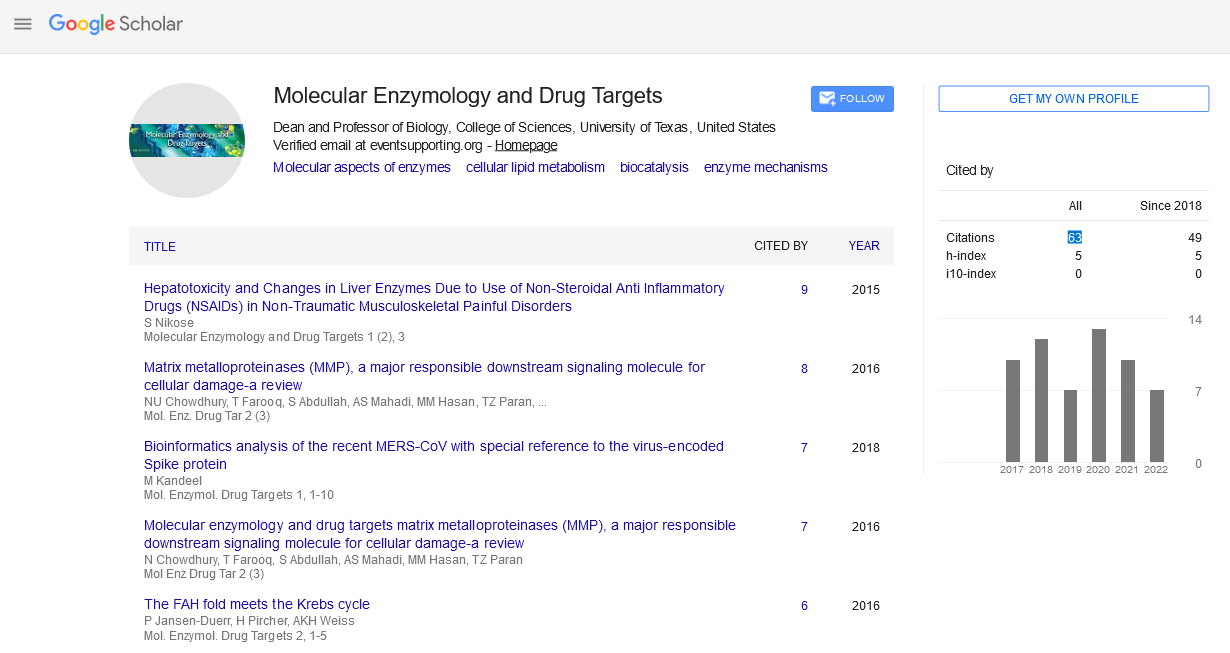Helen Mathews*
Department of Pharmaceutical and Pharmacological Sciences, University of Padova, Via F. Marzolo 5, 35131 Padova, Italy
- *Corresponding Author:
- Helen Mathews
Department of Pharmaceutical and Pharmacological Sciences
University of Padova
Via F. Marzolo 5
35131 Padova, Italy
E-mail: Helen.m@hotmail.com
Received Date: October 8, 2021; Accepted Date: October 22, 2021; Published Date: October 29, 2021
Citation: Mathews M (2021) Use of Nano Particles to Cross Blood Brain Barrier. Mol Enzy Drug Targ Vol.7 No.2:e005
Description
The brain is that the third biggest organ within the body. The
7 mm layer of skull, along with three meninges, protects the
brain from physical injuries. The Blood–Brain Barrier (BBB) is
another membrane that protects the brain. This, as the name
implies, may be a barrier between the blood arteries (capillaries)
of the brain and therefore the cells and other components that
comprise brain tissue. Whereas the skull, meninges, and spinal
fluid protect against physical harm, the blood–brain barrier
protects against disease-causing viruses and poisons found in
human blood.
The blood–brain barrier (BBB) prevents most medications
from entering the brain from the blood. The existence of the
BBB makes it challenging to seek out novel therapies for brain
illnesses or new radiopharmaceuticals for brain MRI. Drugs
having large molecular size cannot cross the BBB. While it's
commonly thought that tiny molecules are widely transported
over the BBB, the truth is that 98% of all small molecules aren't
carried across the BBB. The typical BBB severely limits the transit
of most medications from plasma to the extracellular space,
with over 8-log differential within the entrance rate of small,
lipid-soluble compounds over big proteins. Understanding the
mechanics of medication tarnsport to the CNS requires
knowledge of BBB properties. Apart from unidirectional and
bidirectional transport of small molecules, additional
macromolecules can enter brain tissue via a receptor-mediated
mechanism.
Applying different etchniques for modifying the BBB for
medication delivery to the brain are employed, including
osmotic and chemical opening of the BBB, similarly because the
use of transport/carriers. It's possible to avoid the BBB by
employing a different route of administration, like trans nasal. If
focused delivery to the brain parenchyma isn't desired, other
means of bridging the blood–cerebrospinal fluid barrier is also
studied, or medications is also given directly into the body fluid
channels by spinal puncture. Invasive treatments for bypassing
the BBB include surgical procedures that introduce directly into the brain. The disadvantages of forcefully opening the BBB
include damage to the barrier and uncontrolled drug entry into
the brain. There are several potentially useful treatment
medicines for neurological diseases; however their usage is
restricted because of poor transport over the BBB.
Understanding of the BBB's cell biology has displayed new
routes and possibilities for breaching this barrier.
Use of NPs to Cross BBB
The use of Nano-Particles (NPs) to transport medications to
the brain across the BBB might provide a considerable
advantage over present methods. In contrast to forced delivery
techniques, NPs is also delivered across the BBB by carriers, also
called Nano carriers, without causing any harm to the BBB the
basic good thing about NP carrier technology is that NPs make
amends for the therapeutic drug molecule's BBB-limiting
properties Additionally, this mechanism may delay drug release
within the brain, reducing peripheral toxicity. The sort of
polymer or surfactant employed, the scale of the NP, and
therefore the drug molecule are all factors that impact
transport. Several natural products (NPs) are used for
drug administration via various ways for various bodily
systems, but only those pertinent to the BBB are briefly
addressed during this section. The anticancer medicine
doxorubicin is one example of a drug that has been effectively
delivered into the brain via NPs.
Most of the ways listed for medication passage over the BBB
may be improved by nanotechnology, and a few of the
mechanisms involved include:
• NPs break down the tight connections between endothelial
cells, allowing the medication to pass over the BBB.
• NPs are transcytosed through the endothelial cell layer
• NPs are endocytosed by endothelial cells and release the drug
inside the cell
• NP coating agents like polysorbates inhibit trans membrane
efflux systems (i.e., P -glycoprotein)
• NPs may induce local toxic effects on the brain vasculature,
leading to limited permeabilization of brain endothelial cells.
41685





